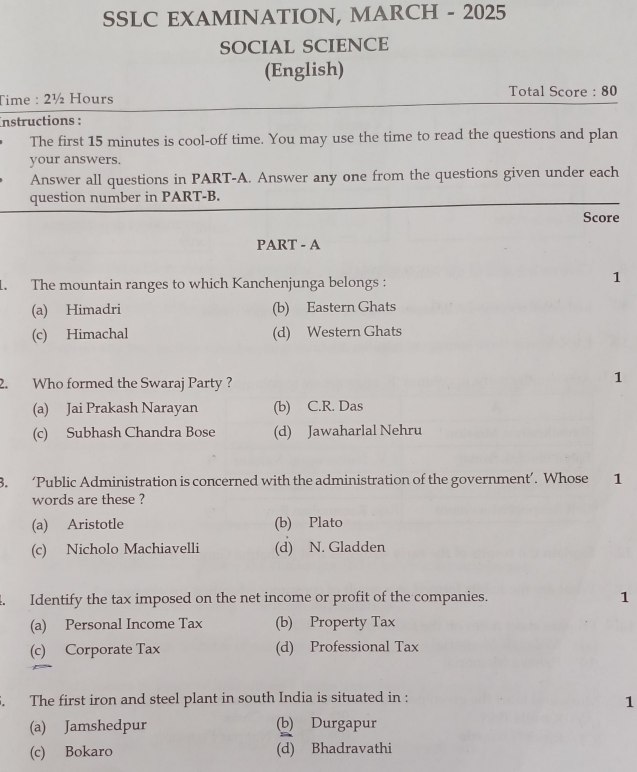The Kerala SSLC Social Science Exam 2025 is an important milestone for students preparing for their board exams. To aid in their preparation and self-evaluation, students can now access and download the question papers and answer keys for all subjects. These resources will help them understand the exam pattern and improve their performance. We will be uploading the latest question papers as soon as they become available, so stay tuned for further updates.
Kerala SSLC Time table 2025: Overview
| Exam Name | Kerala Secondary School Leaving Certificate Examination |
| Board Name | Kerala Board of Public Examinations (KBPE) |
| Date Sheet Name | Kerala SSLC Time Table 2025 |
| Kerala SSLC Exam 2025 Date | March 3 to 26, 2025 |
| Official Website | Keralapareekshabhavan.in and sslcexam.kerala.gov.in |
Kerala SSLC Social Science Exam 2025: Check Question Paper & Answer Key
The Kerala SSLC Social Science Exam 2025 question papers and answer keyswill be available shortly and will be uploaded here. These resources allow students to evaluate their performance and check how they have attempted the exam..
Social Science | Question Paper | Answer Key |
Kerala SSLC Social Science Exam 2025 Question Paper

Kerala SSLC Social Science Exam 2025 Question Paper Download PDF
Kerala SSLC Social Science Exam 2025 Answer Key
1. The mountain range to which Kanchenjunga belongs:
Answer: (a) Himadri
2. Who formed the Swaraj Party?
Answer: (b) C.R. Das
3. "Public Administration is concerned with the administration of the government." Whose words are these?
Answer: (d) N. Gladden
4. Identify the tax imposed on the net income or profit of companies.
Answer: (c) Corporate Tax
5. The first iron and steel plant in South India is situated in:
Answer: (d) Bhadravati
6. Importance of Observation in Sociology:
Answer: Observation is a crucial method in sociology as it helps researchers study human behavior, social interactions, and cultural practices in a natural setting. It allows for in-depth and accurate data collection without relying solely on self-reported information.
7. Complete the Chart:
Answer:
| Indian Civil Service | ||
|---|---|---|
| (a) All India Services | Central Services | (c) State Services |
| Appoints in Central or State Service | (b) Indian Administrative Service (IAS), Indian Police Service (IPS), etc. | Appoints in State government departments only |
8. Non-Conventional Sources of Energy:
Answer:
- Solar Energy
- Wind Energy
- Geothermal Energy
- Tidal Energy
- Biomass Energy
9. Common Characteristics of Himalayan Rivers:
Answer:
- Perennial (flow throughout the year)
- Originate from glaciers/snow-covered regions
- Form deep gorges and valleys
- Carry large amounts of sediment
- Have high water flow and potential for hydroelectric power
10. Sources of Non-Tax Revenue:
Answer:
-
Fees and fines collected by the government
- Income from government properties and services
- Profits from public sector enterprises
- Dividends from government investments
- Grants and aid from international organizations
11. Matching Column A and B:
Answer:
| A (Movements/Organizations) | B (Leaders/Founders) |
|---|---|
| Ramakrishna Mission | Swami Vivekananda (1) |
| Satya Shodak Samaj | Jyotiba Phule (2) |
| Brahma Samaj | Raja Rammohan Roy (3) |
| Self-Respect Movement | E.V. Ramaswami Naicker (4) |
12. Early Struggles of Mahatma Gandhi in India:
Answer:
- Champaran Movement (1917) – First major success in farmers' rights.
- Kheda Satyagraha (1918) – Protest against high taxes during famine.
- Ahmedabad Mill Strike (1918) – Support for textile workers’ wage hike.
- Non-Cooperation Movement (1920) – Boycott of British goods and institutions.
13. Habits Formed by Consumer Education Programs:
Answer:
- Awareness about consumer rights and responsibilities.
- Understanding of product quality and fair pricing.
- Prevention against fraud and misleading advertisements.
- Knowledge of consumer protection laws.
- Encouragement of sustainable consumption habits.
14. Short Notes:
Answer: (a) Malayali Memorial:
A petition submitted in 1891 by the educated Malayalis to the Maharaja of Travancore, demanding better employment opportunities for native Malayalis in government services instead of non-Malayali officials.
(b) Ezhava Memorial:
A petition submitted in 1896 by the Ezhava community to the Travancore government seeking equal job opportunities and social justice, as they faced caste-based discrimination.
15. Marking and Labeling on the Map of India:
Answer:
(A) Kandla Port – Gujarat
(B) Eastern Ghats – Eastern India (Andhra Pradesh, Odisha, Tamil Nadu)
(C) River Narmada – Flows through Madhya Pradesh and Gujarat
(D) Chota Nagpur Plateau – Jharkhand, Odisha, Chhattisgarh, West Bengal
Kerala SSLC Social Science Exam 2025 Answer key will be uploaded soon...
Comments
All Comments (0)
Join the conversation